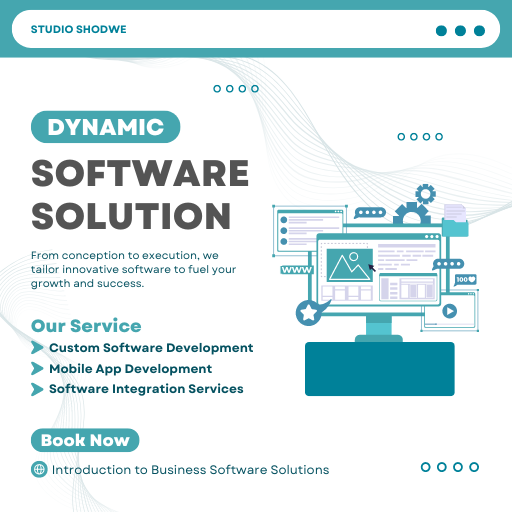Streamlining Business Operations: A Comprehensive Guide to Business Software Solutions
Introduction to Business Software Solutions
Efficiency and operational efficiency are key in today’s fast-paced business environment. Business software solutions are key to achieving these goals, providing tools and systems that automate, simplify, and streamline business activities. These solutions range from robust enterprise resource management systems to specific tools for managing customer relationships and human resources.
Historical developments in business software reflect technological advances and changing business needs. The journey of business software from basic accounting software in the early days of computing to today’s sophisticated, cloud-based integrated systems has been one of rapid innovation and growing importance
Key Categories of Business Software
Enterprise Resource Planning (ERP) Systems
ERP systems have comprehensive assemblies that integrate business processes and functions into one integrated system. They facilitate the flow of information across departments, improving communication and decision-making. ERP includes modules related to finance, supply chain, manufacturing and HR among others, making it essential for large businesses that want to optimize their operations
Customer Relationship Management (CRM) Software
CRM software focuses on managing a company’s interactions with current and potential customers. By centralizing customer information, tracking transactions, and automating sales and marketing processes, CRMs enhance customer service and enhance sales Processes such as contact management, sales automation, and analytics empower businesses to build strong relationships and make data-driven decisions.
Project Management Tools
The project management tools are designed to efficiently organize, execute, and manage projects. They provide services such as task assignment, scheduling, resource allocation and progress tracking. Popular tools like Asana, Trello, and Microsoft Project help teams collaborate more effectively, ensuring projects are completed on time and within budget. These tools are invaluable for maintaining organizational performance and achieving strategic goals.
Human Resources Management Systems (HRMS)
HRMS solutions automate and streamline human resource functions, from recruitment and onboarding to payroll and performance management. By reducing administrative burdens and improving data accuracy, HRMS enables HR professionals to focus on strategic initiatives like talent development and employee engagement. Features like self-service portals, benefits administration, and compliance management are critical for modern HR departments.
Evaluating Business Software Solutions
Assessing Business Needs
Before choosing a business software solution, it’s important to thoroughly analyze the company’s specific needs. This includes identifying pain points, business process inefficiencies, and areas where automation can add value. Involving stakeholders from different departments ensures a thorough understanding of needs, leading to more informed decision-making.
Integration Capabilities
A key consideration in evaluating software solutions is their ability to integrate with existing systems. Seamless integration minimizes disruptions and ensures data consistency across platforms. Businesses should look for software with robust APIs and compatibility with other tools in their technology stack, facilitating smooth data exchange and process automation.
Usability and User Experience
The usability of software significantly impacts its adoption and effectiveness. Solutions with intuitive interfaces, customizable features, and comprehensive support resources enhance the user experience and reduce the learning curve. Conducting user testing and seeking feedback from potential users can help select software that aligns with the organization’s workflows and user preferences.
Cost and Return on Investment
Cost is a critical factor in software selection, but it should be weighed against the potential return on investment (ROI). Initial costs, ongoing maintenance fees, and potential scalability expenses need to be evaluated. A cost-benefit analysis helps determine whether the software’s advantages, such as increased productivity, reduced errors, and improved decision-making, justify the expenditure.
Future Trends in Business Software
Artificial Intelligence and Machine Learning Integration
The combination of artificial intelligence (AI) and machine learning (ML) with business software is transforming businesses. AI-powered analytics provide deep insights, predictive capabilities, and automation of routine tasks. ML algorithms enhance CRM to provide a more personalized customer experience and improve ERP systems by optimizing financial forecasting for supply chain management.
Increased Adoption of Cloud-Based Solutions
Cloud-based business software is becoming increasingly popular due to its scalability, flexibility, and cost-efficiency. Cloud solutions eliminate the need for extensive on-premises infrastructure, enabling businesses to scale their operations quickly and efficiently. They also support remote work, providing access to critical tools and data from anywhere with an internet connection.
Enhanced Cybersecurity Measures
As cyber threats become more sophisticated, the importance of strong cybersecurity measures in business software cannot be overstated. Future features include the inclusion of advanced security features such as advanced encryption, multifactor authentication, real-time threat detection and ensuring data integrity and compliance to lock business customer information protection is paramount.
Rise of Mobile and Remote Access
The shift to mobile and remote work is driving the growth of business software with advanced mobile capabilities. Mobile-friendly interfaces and apps enable employees to perform tasks and access information on the go. This trend supports the growing demand for flexibility and agility in the workplace, enabling companies to maintain productivity regardless of location.
In conclusion, business software solutions are critical for streamlining operations, enhancing productivity, and driving growth. By understanding the different categories, evaluating based on key considerations, and staying abreast of future trends, businesses can make informed decisions that align with their strategic goals. Investing in the right software solutions positions companies for sustained success in an ever-evolving business landscape.
